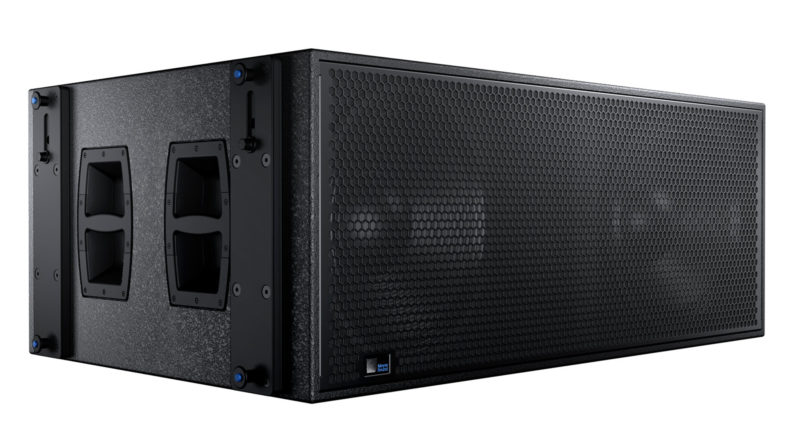Part 4: The Biggest HiFi In The World; MEYER SOUND – METALLICA RIG O2, LONDON 2017
PART FOUR -THE RIG AND HOW IT SOUNDED
There is a wonderful interview on YouTube with Big Mick about sound, Metallica and how he and the band care like crazy about what they call the Near Field experience. Nothing muddled, nothing muffled, and plenty of power, commensurate with the aggression of the music. Eternally modest, Mick describes himself as a bit of a bass monster. But the truth is astonishing. Never before has so much money been spent on bass this deep for the public. Because as described previously, the simple fact is that the ‘˜subwoofer effect’, wherein your mid range and tops sound better, louder, clearer and just plain more potent, as against merely more boomy, after adding a subwoofer, never ever stops. And I mean never
Car audio guys were the only people to fully understand home theatre subwoofer technology when it came out, to grasp the fear register and enjoy shaking you to your bones. However, Bowers and Wilkins’ DB1 subwoofer, several thousand pounds worth, was demonstrated to me by a very clever man. I was played church organ music through two bookshelf loudspeakers. It was delicate and light. No Bach Toccata and fugue here. But when he connected the subwoofer I could feel the space of the cathedral. After two decades I had had my nose rubbed it and was again astonished. Mids and tops sound clearer with a woofer.
And that ladies and gentlemen, is the Secret Of The Metal Overlord! At Glastonbury, when Metallica came on stage, forty-two extra twin 18 inch subwoofers suddenly came to life and enabled the band to subject the Glasto audience to absolutely profound sound that shook their bones and rippled the very sod they stood upon. There were 21 subs under the stage already, so that made it 63 altogether, or 126 eighteens for Metallica’s sub bass. The Meyer Sound loudspeaker products enabled Mick to do this. The Blank Musical Canvas can be configured for whatever power you wish, as long as you know what you want and how you want it.
What Mick wants is sound that can ‘˜crush’ (i.e. be very potent) and for it to have girth (that is, to be weighty and deep and even scary at times) . And this rig at the O2 when I experienced it and all around the world on the WorldWired tour, is exactly what the audience get, courtesy of Mick’s husbandry of this literally awe-inspiring stuff.
Even here in the O2, a now-famously difficult venue to get ‘˜loud’ (as what is, after all, a big stretchy tent tends to absorb energy) Mick got his result. I heard a snippet of Infected Mushroom’s ‘In Front Of Me’(Yeah I had never heard of them either) which is Mick’s favourite test music track. It is full range, impactful and horribly demanding of any sound system. I would of course have loved to have been able to hear the system play at length while I wandered around checking out the coverage but as Mick gave the speakers their oomph, the system was only allowed to play for a little while before the production manager, I gather, ‘˜pressed a button on his iPad’ and cut the feed. I thought ‘Now that is a flipping application!’ All of the equipment, multimillions worth, had a Frankenstein on/off switch on an iPad! He could turn it all off.
Unsurprising but true, the venue doesn’t like it if you make a lot of noise before the show. Mick was quite sanguine about that. However I can tell you that the clarity, potency and reach of the passband of this system was one of the most audibly exciting experiences. It is just so huge, it actually feels like rock’n’ roll. The vocal detail was something I actually got to test myself.
YES I TESTED A MICROPHONE ON STAGE AT THE O2.
I was so excited I nearly swallowed my tongue. Trying to act cool and failing miserably. However, as you can see in the video, the vocal sound was just bloody vast and it sounded like the bloke. I spoke to him face-to-face. I heard him giving it large as can you on the soundtrack to the video. He sounded the same, just MUCH bigger and lot more excited than when chatting.
Of course it would be brilliant if I could have made a little slice of video during the gig. But I chose a very high-quality stereo microphone, complete with a -10dB pad switch, so in theory it can cope with 155dB. With the 4K broadcast JVC camera, I think the recording would be what they call a bootleg and I don’t fancy being sued by a major corporation, which is only way to describe the operation. It is all fully professional these days. I would love to see what my lovely new camera would make of the show, though.
OK, system diagram time. a massive thank you for the skill and time put into this by Chris Soteriou, who is a natural at this stuff. He collated all thumbnails and was even able to grasp what the hell I was on about. He’s a star and I will be working with him again, as I reckon if he can do this, then his beloved subject of car audio (yes, he too, is a ‘˜lifer, poor soul!) will be a doddle for him to create pretty system diagrams of feature cars.
MEYER SOUND LEO FAMILY ENCLOSURES USED AT THE O2 – WORLDWIRED TOUR
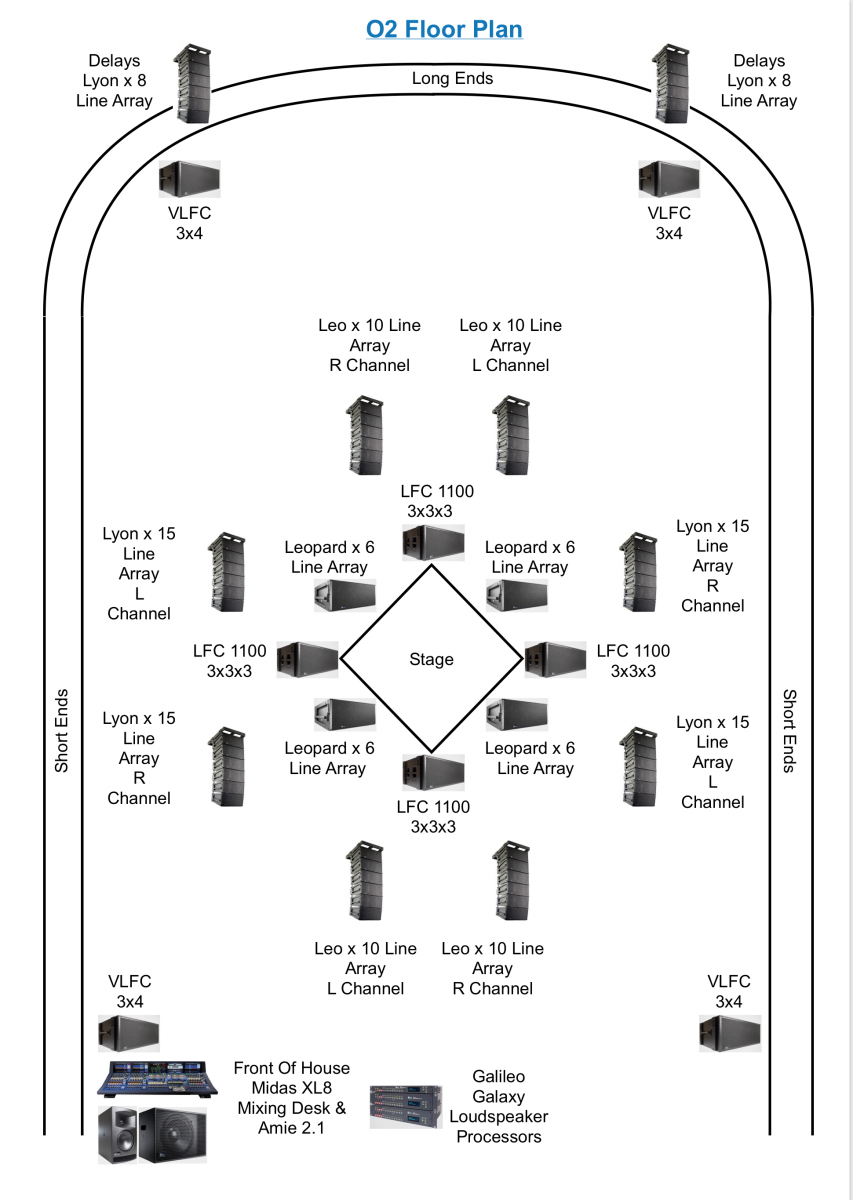
by Chris Soteriou
I bloody hate spoilers so I will not reveal show details but I can explain that during one song, there is the use of a pyrotechnical explosion. I had it on first-hand from someone who was actually at the gig, that they thought they had set off explosions that shook the hall. This is because of what is technically termed infrasonics. That is the stuff which still comes out of the loudspeaker, yet is absurdly below even the 11 Hz stated lower cut-off frequency of the forty-eight VLFC enclosures stacked in the corners, twelve tucked in each corner and at the O2, used to stand some lamps upon – the bit when I say ‘ooh pretty lights!’. We’re talking about the initial airshove of ninety six eighteen inch woofers, all tuned to play flat down to nearly ten cycles. In other places in the show these frequencies are used deliberately to make your adrenal glands pump their go-go juice into your system. A sequence with emotive visuals and some SFX that include profound use of profundity. That part shook the O2 to its very roots, and could be felt like a seismic event in corridors nearby, backstage, out front, everywhere.
How the flown 1100-LFCs spread their bass goodness about the O2.from above
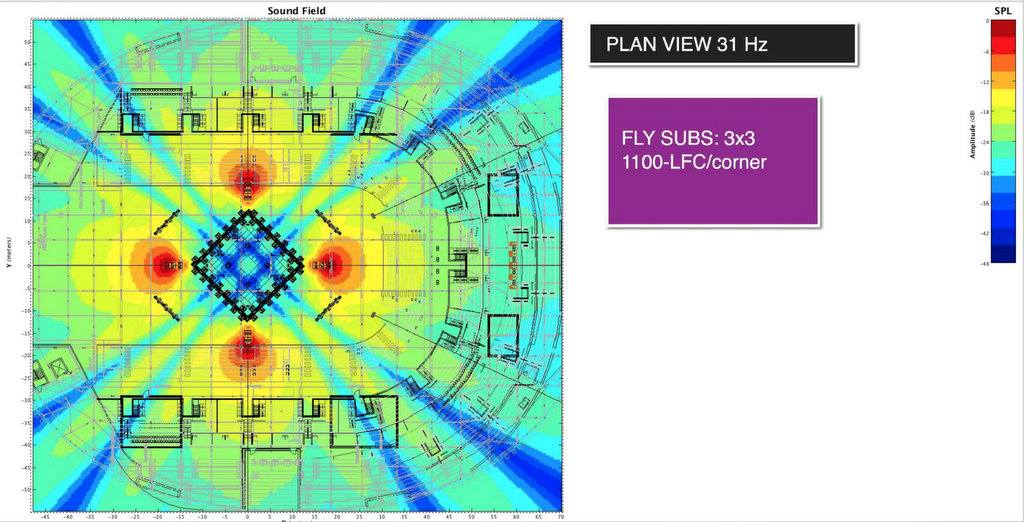
Despite a raging ‘˜speako’ in the video, the next enclosure to talk about is the 1100-LFC. Passband about 30Hz to 80Hz. They used three stacks of three of these, flown at each corner of the stage. In a ‘˜step array’. Each stack is a tad lower than the one behind it, which gives the bass, which IS a bit directional in intensity of output at this scale and level, a shaped throw. That means it is bulbous downwards at the punters underneath, as well as flinging lows at the audience directly in front of them, in the tiered seating. That’s eighteen eighteens at each corner of the stage.
If you are hardcore, you may want to be ‘˜on the barricade’ or right up close to the stage. Some fans have been known to queue for a day or more to be at the front. And that deserves to be an intense experience. So, at this show, halfway along each straight side of the stage, there is a cluster of six compact linear line array Leopard enclosures. These are trussed into a single face, so are throwing down HARD onto the hardcore at each face of the stage. So, 24 boxes each with two nines and a three inch compression driver pumping mayhem upon them.
Now an arena like O2 is NOT round, even if the tent is. There are ‘˜long ends’ and ‘˜short’ ends’ to the throw requirements of the P.A. And up in the ‘˜Gods’ or the highest and furthest-away seats, they have also got their own little line arrays. This time it is eight Lyon enclosures each side as left and right, for yes, despite performing in the round, the band is mixed into a gentle stereo, to give texture. Each corner of the square stage in the middle, is the centre of a stereo pair. Thus these two stacked line arrays of Lyons, facing the most distant audience with their paired fifteens and twin four inch compression drivers exciting the horn within, are in fact reinforcing the output of the line arrays closer to the stage. That ‘˜long end’ axis has a pair of lines comprising ten Leo boxes each side. Mirror imaged backwards and another two arrays of Leo are facing the back of the hall, each of the four arrays, having their bottom parts bended around to cover the audience best. On the short ends, or sides of the arena, the audience are faced with two massive fifteen-box line arrays of Lyon. That’s a good curve downwards by rigging and huge power.
It is a fraction the physical size of the stuff I used to hump about as a student but the output is astonishing. And here is the coolest thing. This was such a treat to see, but Meyer produce graphics for touring systems’ designers to see projected output in terms of spread and decibels with distance and show the engineer diagrams of the pattern of sound for that system design at different frequencies. The bass ones are awesome, well they all are, but check out the amount of oomph.
And the 31Hz efforts from sideways on; pretty plot, huh?
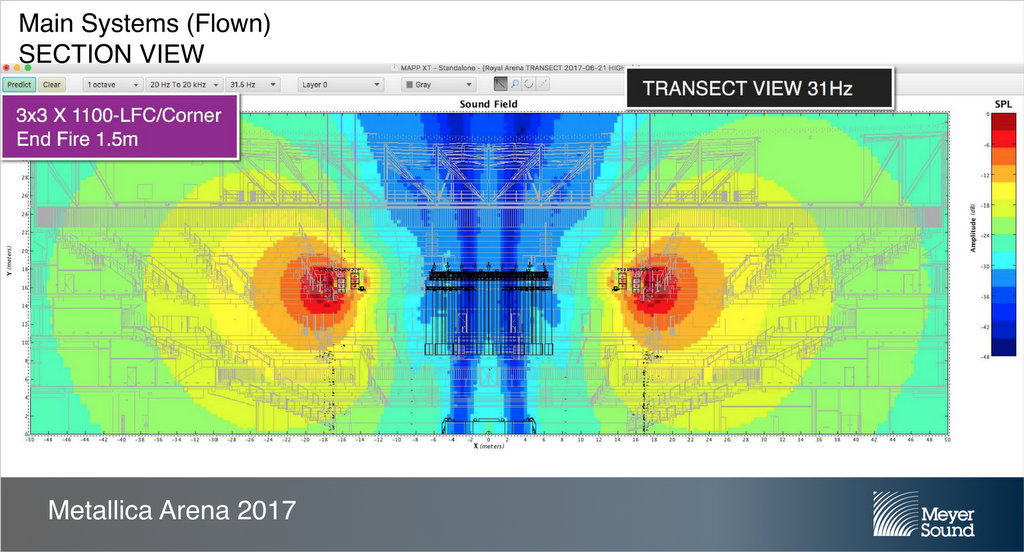
And 63Hz
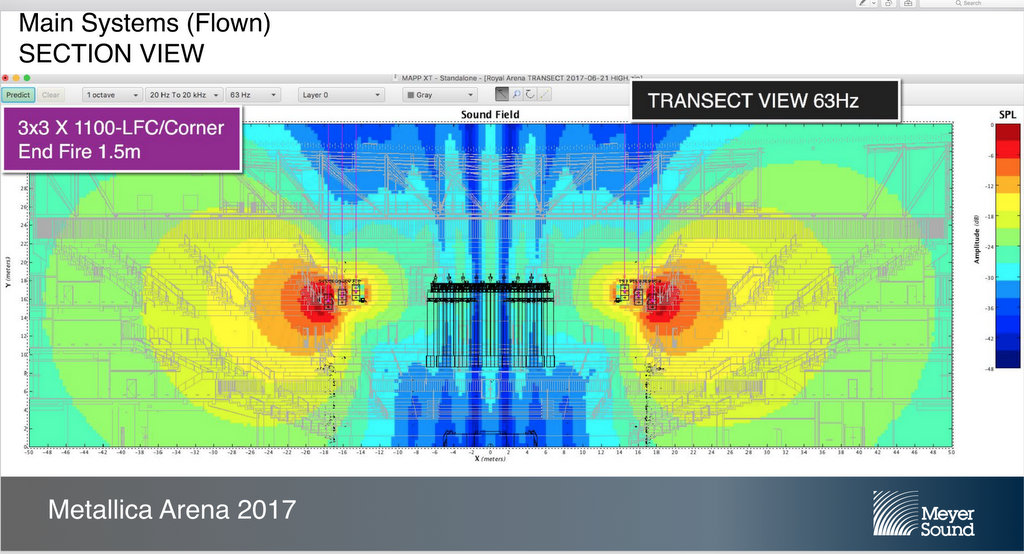
Finally, there were a slew of stage wedge monitors, mixed for the band to hear best what they are playing. Below is the design. They are all either twin ten inch-plus horn MJF 210 or else the bigger brother, the MJF 212 with two twelves to marry the horn. Paired MJF 210s are used straddling each corner of the stage, with a single MJF 212 next to these, used solely to rip the air asunder with the guitar of whomever is stood before it. Another pair of MJF 210s are found halfway along each long side of the stage. So sixteen MJF 210 and four MJF 212.
The stage monitors, another neat effort from my new graphical assistant!
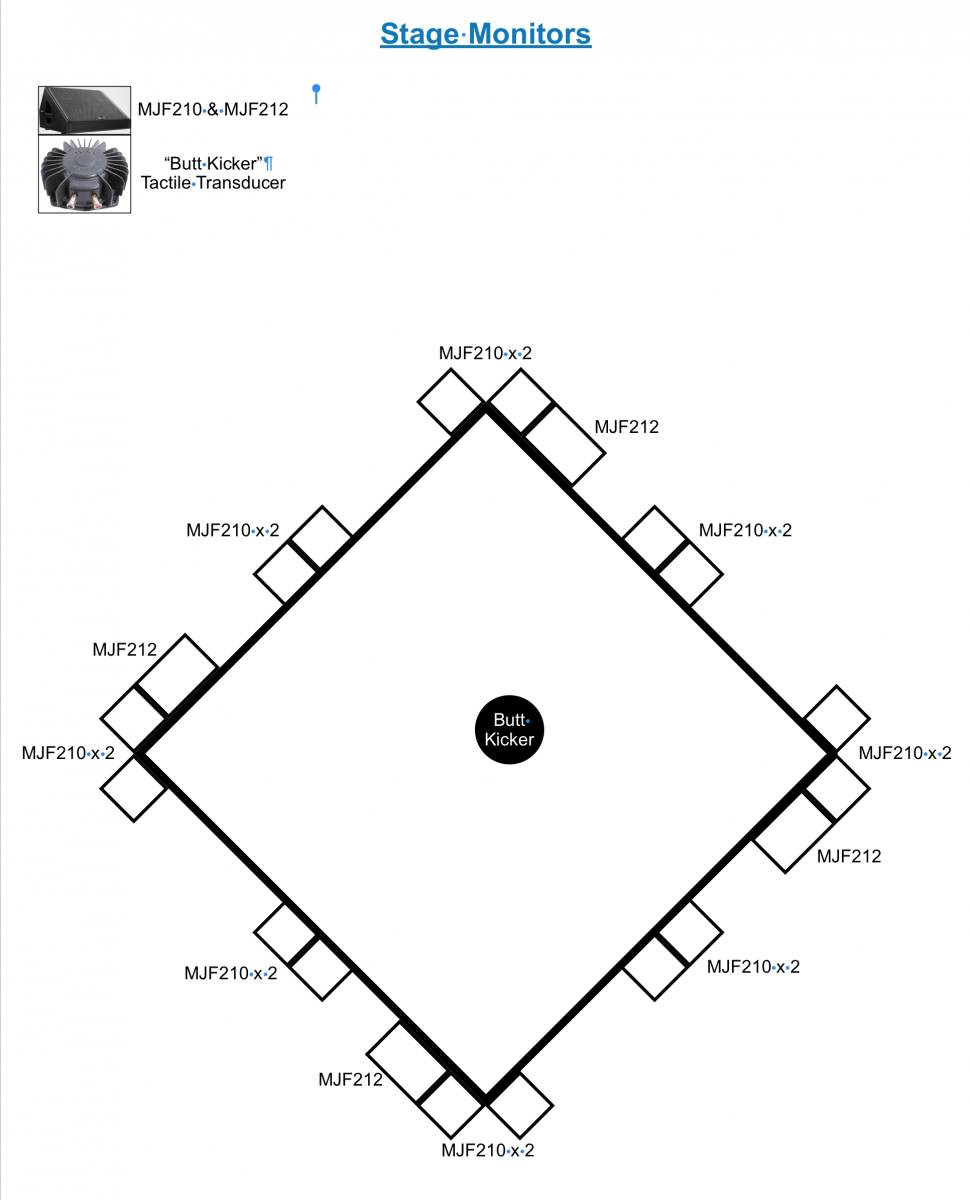
by Chris Soteriou
The last actual moving coil transducer to do with the show was a single one thousand watt ‘˜Butt Kicker’. This is derived from car audio and its descendants are also found in the Bentley Bentayga. The heavy magnet moves, not a cone of paper. It is on a big powered voice coil all right, but the heavy bit is suspended, not the light bit. Fix it to a panel and a car can feel like it has fifteens in it, when it didn’t. Fix one under a drum stool and the stuff the drummer is playing can be communicated to him, directly..up his or her butt.
This really was a glorious experience for the concert goers. I had an absolute blast making the video, as well as getting to hang out backstage, before the stars arrived of course. I wish to offer my old mate Big Mick a great big man hug of a thank you and to express my admiration of John and Helen Meyer, the company bosses, who make the best technical and business team in all of pro loudspeaker technology. Because as far as I can tell, everybody else has been in their wake, since the first time they hit the market, all those years ago, when I was a roadie called ‘Tarmac’.
The Meyer LEO family has to be at the very top of the tree of the world’s clearest and best musicians’ blank canvas, with no apparent limit to scale or magnitude. The recurrent theme through everything I have learned about this company’s products is that the sound has no ‘˜flavour of its own’. And that is about as big a compliment as I’ve never heard in pro audio. It truly is the first generation creators’ Holy Grail. As passionate as hi-fi manufacturers are about recordings being reproduced faithfully, Meyer Sound are clearly as passionate about possessing that transparency, that utter lack of any colouration, that shows in their products.
Adam Rayner OnLine Editor
I want to offer a massive thanks to Chris Soteriou, whose diagrams were the keystone to the arch of this story.

